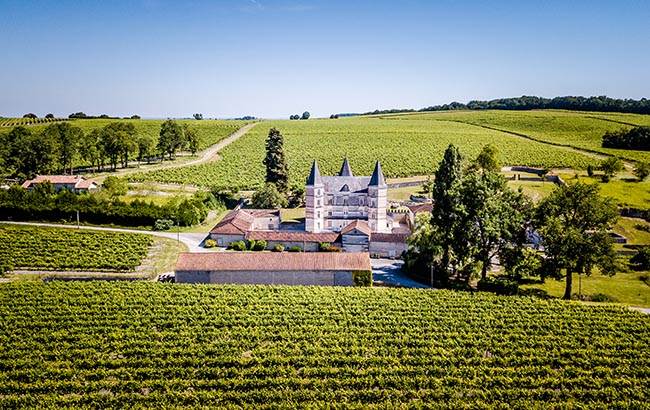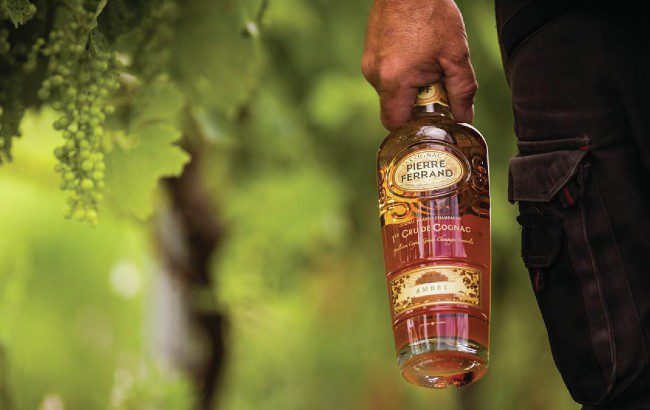Cognac to the future: a modern makeover
Producers are determined to move Cognac away from its somewhat stuffy image, with brands using streetwear and cocktail culture to give the brown spirit a fresh makeover.

*This feature was originally published in the May 2023 issue of The Spirits Business magazine.
The world’s most celebrated brandy is at an interesting crossroads. While the future looks bright for Cognac, as consumers clock onto the value to be found in the category, volume sales of the grape-based spirit fell last year.
According to the latest figures from the Bureau National Interprofessionnel du Cognac (BNIC), global volumes dropped by 4.8% in 2022 to 212.5 million bottles, as the world grappled with rising inflation, an energy crisis, and the aftershocks of the pandemic, with China still facing lockdown restrictions late into the year.
Despite the dip, 2022 was the third most successful year in Cognac’s history, with value sales rising by 8.4% to €3.9 billion (US$4.3bn). Around the world seven bottles of Cognac are sold every second, according to the BNIC, and future growth is on the horizon for the category, which is making great strides in widening its appeal to a younger audience. As the prices of old single malts reach increasingly dizzying heights, Cognac has a golden opportunity to steal some of Scotch’s market share by branding itself as an appealing affordable alternative with a terroir story to tell, while in the on‐trade the spirit has untapped potential to shine in twists on classic cocktails, quirky new creations or as a refreshing long drink.
With less than 3% of Cognac consumed in its homeland of France, the US and China remain the two most important markets for the spirit, with the former accounting for around half of annual global sales. Volume sales dipped by 3.2% in the US last year to 111.3m bottles due to a perfect storm of supply issues, rising inflation, a drop in demand and logistical disruptions, though, as IWSR Drinks Market Analysis research director Daniel Mettyear points out, this followed an exceptional 2021.
“Looking at 2019 as the base year before the pandemic, 2022 volumes for Cognac are still 17% larger than in 2019,” he says.
“The 2022 decline is not indicative of a long-term trend, and is relative to a transitory period as the segment cycles through significant volume gains during the pandemic. Slight to moderate growth is expected into the future.”
Cognac’s volume decline in China last year was more marked, at 12.8%, as cities remained on lockdown, with restaurants and bars shuttered. “We are facing a drop,” BNIC president, Christophe Veral, said in January. “The drop is not just for Cognac, it’s for the world economy, and we’re going to rebound. Cognac is a spirit from a terroir, and in a world that’s looking for authenticity, with its guarantee of origin and its authenticity, Cognac knows how to offer that. It’s a landmark in an unstable world.”
Sales bounce back
This year, sales are set to bounce back in China as the country opens up again after years of restrictions, and the prized elixir – which is ubiquitous at special occasions in the country, from weddings and banquets to birthday parties – flows once more. “2023 is going to be a year of recovery for China, where we’ll see a lot of Western spirits gain sales, especially now that the on‐trade is open again. It will take time for consumers to be confident about going out and spending again, and how and what people drink might be different,” says Mettyear.
He reveals that Cognac is forecast to grow at a compound annual growth rate (CAGR) of 6% in both volume and value terms in China between now and 2026. Meanwhile, the return of business and leisure travel in China has been a shot in the arm for duty free Cognac sales. “In this context, merchants are maintaining their investment pace in Cognac and the sector remains vigilant but confident in its mid‐ and long‐term growth prospects,” a BNIC spokesperson told SB.

Thomas Soret, communications manager at Frapin, is confident sales in China will rebound this year. “Covid blocked a lot of business in China, but the market is opening again, big fairs are taking place, and people can travel easily around China now,” he says. “The key to growing our presence in China lies in tastings, as we need people to taste our Cognacs to understand their quality.”
In the US, meanwhile, a new importer and a collaboration with French basketball player Rudy Gobert, who shoots hoops for NBA team the Minnesota Timberwolves, is helping Frapin to make its mark in the country.
Also enjoying success in the US is Maison Ferrand, which increased its volume sales in the US and Canada last year. Marketing director Angélique Jullienne believes the brand’s appeal lies in the craftsmanship behind its products, and the fact that they have a story to tell. “Our unique approach to Cognac making, which involves different grape varieties in addition to Ugni Blanc, such as Colombard and Folle Blanche, and experimenting with double maturations, resonates with consumers who are looking for something new and exciting,” she says. The house has been growing its presence in the US by taking part in key industry events, including Bar Convent Brooklyn and Tales of the Cocktail in New Orleans, and working with top mixologists to create innovative cocktails that showcase Cognac’s versatility.
Aside from the major players of the US and China, the Cognac market remains fragmented. For producers keen to explore new frontiers, there’s a chance to make a splash in burgeoning export markets, with South Africa, Nigeria, Vietnam, and Canada poised to enjoy significant growth in the next five years. “Cognac’s growth is being driven by the upper middle class in South Africa, where it’s seen as a status symbol, which is driving its popularity in the on‐trade, especially VS and VSOP expressions,” says Mettyear.
Where South Africa leads the rest of Africa follows, and interest is starting to trickle down to Kenya and Nigeria, where consumers are keen to be seen keeping up with the Joneses. With so little consumed in its homeland, Cognac producers also have an easy win if they’re able to convince their compatriots to dare to drink the spirit outside of the realms of the ‘after‐dinner leather chair and snifter’ scenario – astereotype that’s proving hard to smash in France.
Much like the idea of popping an ice cube into a glass of Champagne would provoke gasps of horror among the French, so too does the concept of enjoying Cognac as a mixed drink with tonic, soda water or ginger ale, despite it working well in long serves.
“Cognac is so mixable. It’s intense and offers delightful fruitiness, structure and poise,” says Hannah Lanfear, advocacy and content manager at London’s Speciality Drinks. “I hope that bartenders will begin to see the potential for Cognac in fun, fruity long drinks. It’s not just for stirred‐down drinks.” She believes attitudes towards Cognac serves are shifting in France.
“The Cognaçais have evolved in response to how the world wants to drink their spirit. We’re not told we mustn’t mix it with tonic anymore, which is good because it’s delicious. People need to start seeing Cognac as a spirit to mix with. It makes a wonderful Highball.”

The spirit is doing well in the UK, where last year volume sales were up by nearly 4% to 8.27m bottles. At Speciality Drinks, sales have risen by 18% since 2021 following growing demand for premium and super‐premium expressions.
Lanfear says: “There’s such a diversity to the profiles of the eaux‐de‐vies that go into a Cognac blend, and I think we’ll start to see producers offering more ‘small batch’ Cognacs that are more specific in character and flavour, along with more single‐cask Cognacs such as the Delamain Pléiade Collection, which represents astonishingly good value right now.”
The thirst for top‐end Cognac is showing no sign of slowing in the UK. Ticket sales for this year’s Cognac Show in London were up by 20% on 2022, while the show’s shop increased its sales by 76% this year, with the average spend rising to just shy of £100.
“People are finally realising the value and potential of Cognac,” says Dawn Davies MW, head buyer for The Whisky Exchange. “With rising prices of older aged whiskies, an aged Cognac is much more approachable, and with so many new independent bottlers producing incredible liquid, it’s a strong investment.”
Best foot forward
Keen to prove that they’re down with the kids, Cognac producers have been drawing inspiration from footwear in some of their latest marketing initiatives. Kicking off the trend was small player Larsen, which launched a limited Sneaker Edition of its VSOP expression in September 2022 in a tribute to street fashion. Seeking to smash tired stereotypes, and connect with a younger audience, Larsen took cues from the fashion industry for its bespoke bottle, which featured a leather label with stitching detail, shoelaces, a metal buckle, and the brand logo in gold.
“The Cognac category is exclusive, but can sometimes feel homogeneous. Larsen would never have existed if it weren’t for the bold and curious mindset of our founder. That’s why we wanted to step out of the category and become a natural part of street fashion,” Larsen’s senior brand manager, Audrey Fischmann, said.
Not to be outdone, in December 2022 Martell hooked up with Felisha ‘Fe’ Noel, founder of womenswear brand Fe Noel, to launch the Martell Sneaker Atelier in New York’s Meatpacking District, which allowed Cognac fans to co‐create a bespoke pair of trainers using ‘brainwave technology’. Donning brainwave ‐sensing headsets, participants’ positive holiday memories were interpreted and turned into vibrant colour patterns on their chosen pair of kicks, which were hand‐painted on site and customised with gold charms by jeweller Johnny Nelson.
Completing the hat‐trick, in March of this year Hennessy took things a step further via a collaboration with British fashion designer Kim Jones on a pair of limited edition trainers. Called the HNY Low by Kim Jones, the basketball‐inspired, £620 trainers feature the Hennessy XO x Kim Jones logo on the underside, and the initials KJ and the Hennessy emblem on the heel.
“I wanted it to be elevated and chic, to reflect the long heritage of Cognac and my own design values,” Jones said. “It’s a glass of Cognac in sneaker form.”
More tortoise than hare, the future growth of the Cognac category looks to be slow and steady, with the IWSR predicting global sales to increase at a CAGR of 5% in volume and 7% in value between now and 2026. Highlighting the premiumisation trend in play, the volume of the super‐premium‐and‐above segment of the global Cognac sector is forecast to rise at a CAGR of 9% over the same period, which bodes well for quality‐driven producers focused on the sharp end of the market. To win over a new generation of drinkers, producers need to be telling their terroir stories, highlighting their sustainable credentials and flagging up the time and toil that goes into producing these cask‐aged spirits.
Lanfear of Speciality Drinks believes that having long played second fiddle to Scotch, Cognac’s breakthrough moment is fast approaching: “The category has so much potential to become more specialist in its approach,” she says. “The fact that these are complex, pot‐distilled spirits means they are well suited for magical evolution in cask, and with the prices of Scotch single malts running ever higher, there’s exceptional value to be found in single‐cask Cognac.”
Related news
Cocktail stories: Speed Bump, Byrdi
